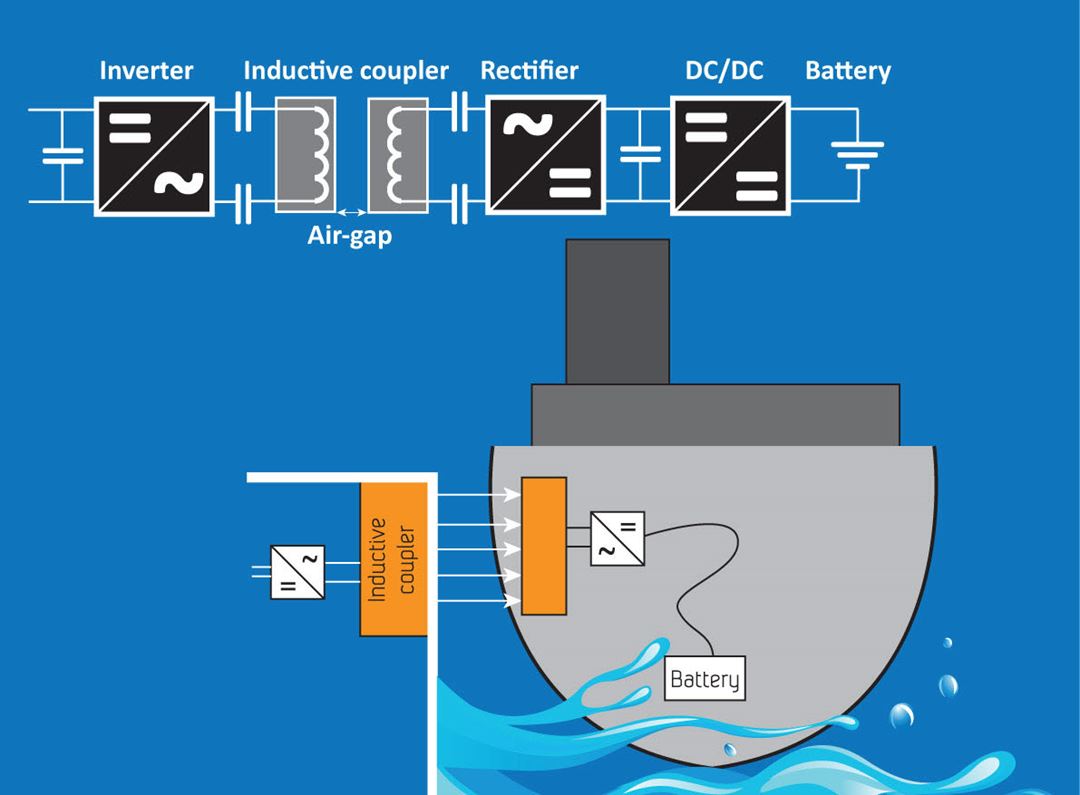Download relevant pictures for editorial purposes in our "On Beyond Oil"-album at
Norway has been for long time at the forefront in reduction of emissions and electrification of ship propulsion systems. The world's first fully battery-powered electric ferry started regular operation in Norway in 2015, and the Norwegian government plans to require zero emission operation in several contracts for ferry operation that will be renewed in the coming years.
Short stops for unloading/loading
Some ferries have very short stops for unloading/loading, and there is little time for connection of conventional plugged solutions for high power transfer. Thus, solutions for fast connection and disconnection of power supply for battery charging are necessary. Therefore, several systems have been tested for automated connection for battery charging of ferries. However, the harsh and salty environment and the frequent operation makes it preferable to avoid direct electrical and mechanical contacts when charging the batteries during each stop.
The project
In 2012, Wärtsilä Norway started considering the possibility for high power battery charging in ship operations without need for mechanical connection. This option was inspired by the rapidly ongoing development in wireless inductive battery chargers for electric cars, busses and trams. However, in case of ship applications, the power levels are significantly higher and the operational requirements are different compared to stationary charging of electric vehicles. Typically, a power level in the range of 1 MW and an airgap distance of up to about 50 cm is needed, while the largest available systems for inductive charging in public transportation systems has until recently been 200 kW with much shorter airgap distance.
With support from the Norwegian Research Council, Wärtsilä Norway AS, the shipyard Fjellstrand, the ferry operator Norled and the local utility company SKL Nett started a research project in cooperation with SINTEF Energy Research.
Starting from a feasibility study of MW-range inductive power transfer fulfilling the requirements of electrically powered ferries, the project proceeded to develop a complete concept for high power wireless battery charging in ship applications. To our best knowledge, no similar system has been previously proposed or demonstrated. The research activities at SINTEF Energy Research provided the basis for selection of the system configuration, a design methodology for the main components and the design of control strategies for the power conversion system. After testing of a small-scale prototype in the laboratories at NTNU/SINTEF, a full-scale prototype was constructed by Wärtsilä Norway and contactless power transfer beyond 1 MW was demonstrated for an operating range from 15 to 50 cm airgap distance.
Background numbers and figures:
It has been estimated that Norway has about 60 ferry services (with about 80 ferries) that can be electrified by using fully battery-powered operation while still providing economic benefits due to reduced fuel costs. Another 30 ferry services (with about 40 ferries) can benefit from plug-in hybrid operation with re-charging of the batteries from the onshore power system.
Today the diesel-electric ferries in Norway emit about 400 000 tons of CO2 per year. About 300 000 tons of these emissions could be eliminated by the economically beneficial solutions for battery powered and hybrid operation. This would also reduce the emissions of NOx by about 8 000 tons/year.
Technology for hybrid or purely battery-powered operation can also find application in many other applications, for instant shuttle boats in urban areas, short-sea shipping for coastal transport etc.
Current situation in Norway and worldwide
Wärtsilä has signed an agreement with Cavotect to develop a concept for inductive charging integrated with a vacuum-based mooring system. The main motivation for the vacuum mooring is to be able to stop the propellers during docking, and thereby save energy and reduce the requirements for onboard battery storage.
Norled and Wärtsilä Norway are currently operating a hybrid test ferry in regular service. There are plans to upgrade this vessel with possibility for inductive charging during 2016-2017, with subsequent regular operation as a pilot installation in 2017 for demonstrating wireless inductive battery charging of about 1 MW.
No other similar projects have been officially announced, and this is expected to become a unique achievement. It is also planned to launch the developed system on the commercial market during the coming year.
Future trends
Further news about the planned product development from Wärtsilä and Cavotect can be expected in the coming year, as well as news about the plans for the full-scale demonstration of the inductive charging system in regular operation.
The concept as it is already developed is at a stage where commercialization and production for special application can already be started. However, there are several relevant research tasks to be addressed to achieve further improvements, including optimization of performance and minimization of losses. Several groups at SINTEF and NTNU are therefore looking for opportunities to start further research activities, on further improvements of the high power system for ship applications as well as for other potential marine applications of similar systems.
Additional information:
- Wärtsilä: http://www.wartsila.com/media/news/25-01-2016-wartsila-and-cavotec-to-develop-worlds-first-marine-wireless-charging-and-mooring-concept
- The project was featured in shipstonorway.no
Industrial contact: Ingve Sørfonn, Technical Director, Wärtsilä Norway,
* This text is background information for the participants at the "On Beyond Oil"-event.


